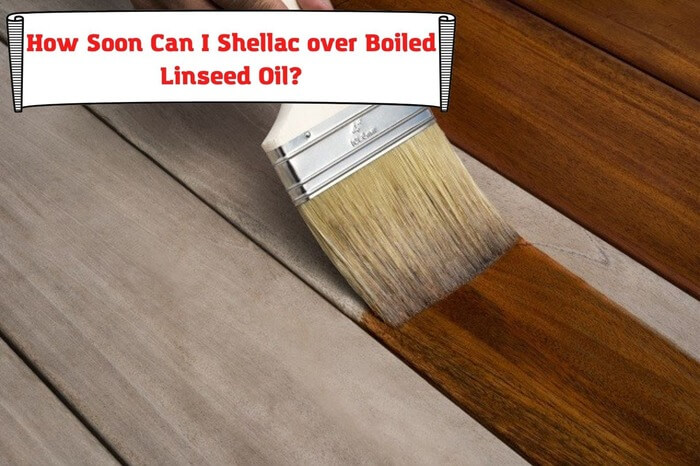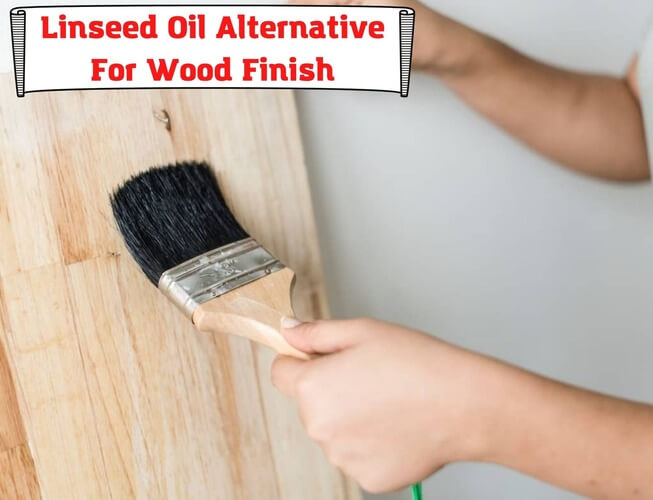
After constructing a piece of furniture, you should choose the type of finish you’ll give the wood. Finishing is important in woodwork. It’s what makes a difference between shoddy and presentable work. Many of us try a lot of finish tricks such as painting and varnish to make our work look presentable.
Shellac and boiled linseed oil are two great products that can give your furniture piece a sleek and glossy finish. But can you actually apply shellac on top of boiled linseed oil? And how soon can you shellac a piece of furniture after applying boiled linseed oil? Let’s find the answers below.
What Should You Know About Shellac?
You shouldn’t leave the wood in its natural state. The wood needs protection; otherwise, it will be damaged or soiled too easily. Shellac is an effective transparent, protective finish that helps preserve the true wood color. This wood finishing product provides a hard and glass-like surface.
When you apply it on wood, shellac brings out more grain (depth) and color. What’s more, this finish is fast drying. That means you can apply multiple coats of shellac, almost immediately one after another. Unfortunately, shellac doesn’t offer a durable coating. This lack of durability requires frequent retouching with new shellac or alcohol. For this reason, we don’t recommend applying shellac on furniture that’s likely to experience hard wear. Shellac is soluble in several household liquids like alcohol, thinners, soaps and detergents, ammonia, and hard water. It’s not compatible with cedar, ebony, or teak. Shellac is also known to have a very short shelf life.
What You Should Know About Boiled Linseed Oil

Boiled linseed oil (BLO) is another transparent, protective wood finish. When you apply it properly, BLO won’t just seal the wood but will also offer a very durable finish/shimmer. With this finish, you can provide a mellow and patinated finish to any type of wood apart from exterior oak. However, Boiled Linseed Oil seems to work best on cherry. This finish can also seal stone floors and other porous surfaces prior to waxing. You can use this finish on metals as well.
Unlike shellac, BLO doesn’t cure quickly. Indeed, many woodwork experts regard this finish as a “drying oil”. It will take 24 to 72 hours to dry out to the touch but can take longer to cure completely. This finish can become dark when exposed to the air. It can even turn black after exposure to vinegar or other mild acids.
Is It a Good Idea to Shellac over Boiled Linseed Oil?
We’ve seen many woodworkers apply shellac over the boiled linseed oil. However, just because many people do it doesn’t mean that it’s okay. So, is it a good idea or a waste of time?
There are two reasons why you would want to apply shellac over a previous finish – BLO in this case. One is that once you fill the pores on the wood with BLO, shellac will serve as a barrier coat. That’s because it is fast-drying (a matter of hours). On the other hand, BLO takes at least 24 hours to dry. That means you can’t apply a second BLO coat on your furniture piece the same day. The second reason is that shellac adds great depth and improves the vibrancy of the natural wood color. There aren’t many other finishes that do better than shellac in that aspect.
Shellac doesn’t have any drying elements in it and won’t help BLO cure faster. All finishes will cure after a certain period of exposure to oxygen. There’s a difference between hardening and curing. BLO dries (hardens) quickly but takes a lot of time to cure completely. Therefore, when you seal a non-cured base, you prevent oxygen from getting onto that base. In other words, the base won’t cure any time soon.
Shellac doesn’t create a very long-lasting result. And although shellac is water-resistant, it’s not waterproof. It also dissolves in alcohol. Therefore, from a protection point of view, putting shellac over BLO offers very little.
Although boiled linseed oil will harden quickly (probably in 12 hours), it won’t cure fast. BLO will remain a soft finish even when it’s cured. It can take up to 3 weeks to completely cure. So, putting shellac over a non-cured finish (BLO) will generally provide a hard covering over the boiled linseed oil. Even if you apply shellac over BLO before it cures completely, everything will dry just fine. But, if you sand shellac back, you’ll notice the smell of the oil once it’s re-exposed. That simply means that the BLO hadn’t been cured fully.
Any topcoat or finish reduces the pore sizes on the wood. When boiled linseed oil is the base coat/finish, then it means that it’s serving the pole filler (soft finish). Any second coat will now make the result smoother and glossy. But some people argue that it doesn’t make sense to put another finish on top of it. And if you have to put on another coat, many experienced woodworkers stress that you use dewaxed shellac.
The Use of Dewaxed Shellac over BLO
Applying dewaxed shellac over boiled linseed oil is quite common. Many professional woodworkers do it to enhance the beauty of their furniture pieces. Apparently, dewaxed shellac creates a perfect finish. Moreover, touching up with extra coats of shellac is easy. But, it’s still not very durable. Generally, dewaxed shellac is an excellent choice to use over BLO. It adheres well even when the oil isn’t cured completely. If you’ll be using oil-based poly, it’s good to use dewaxed shellac as it will make the poly adhere better.
So, back to the question – whether or not it’s a good idea to use shellac over boiled linseed oil. Well, that depends on two factors. One is the amount of movement that would happen under shellac. The other factor is whether or not BLO is cured completely. If BLO is thin and fully into the wood, then there will be reduced movement. Applying shellac in that case wouldn’t be a waste of time.
On the second factor, it’s important to give BLO time to cure before applying shellac. By giving it time, you’ll get better results once you apply shellac (dewaxed). But, considering that BLO doesn’t cure quickly, how long should you wait? Let’s find that out below.
How Soon Can I Shellac over Boiled Linseed Oil?

We have concluded that it’s fine to lay down a coat of BLO on a furniture piece, allow it to oxidize, and then apply shellac over it. Assuming that you’ve put a thin coat of boiled linseed oil on the wood, you can apply shellac over it in 24 hours. Waiting for 72 hours before topping BLO with a coat of shellac would even be better. That means BLO will take between 24 and 72 hours to cure. However, the curing process may take longer during cold days.
Note: You would need to wait for days or even a week if you applied a coat of raw linseed oil.
Is it not possible to apply shellac immediately? Well, although we don’t really recommend it, many woodworkers have applied shellac almost immediately. It means waiting for the BLO to dry for about 30 minutes and then applying a coat of thinned shellac. The best thing with shellac is that it cures quickly. Thus, it means you can apply multiple coats within a short period.
But we still insist that you wait for at least a day before adding a coat of shellac on boiled linseed oil. Remember that linseed oil gets dark when exposed to oxygen. For that, you don’t need to worry about it as you’ll top-coat it with shellac. The finish will add its color and adhere very well even when the BLO isn’t cured fully.
Closing Words
It’s hard to obtain excellent results in woodworking without using a proper wood finish. When you have completed making that beautiful piece of furniture, you need to find the perfect finish for it. Shellac and boiled linseed oil are two popular finishes that can give your work a sleek and professional touch. But many woodworkers get quite confused when it comes to using these finishes. That’s particularly true for the question of whether it’s possible to put shellac over boiled linseed oil. While some of us argue that it’s a waste of time, many believe that it’s worth it.
Shellac is an effective barrier coat as it dries quickly. It creates a perfect finish; adds depth and vibrancy to the wood. What’s more, we have mentioned how soon you should put the coat of shellac over BLO. You should wait for at least a day for the linseed oil to cure. The results would be better if you waited for 72 hours.
- How Long To Wait Before Sanding Acrylic Enamel Paint? Quick Tips - January 31, 2022
- Lacquer Over Boiled Linseed Oil. Things You Should Know - January 30, 2022
- Shellac vs Danish Oil. We’ve Found Out Which One Is Better - January 25, 2022



